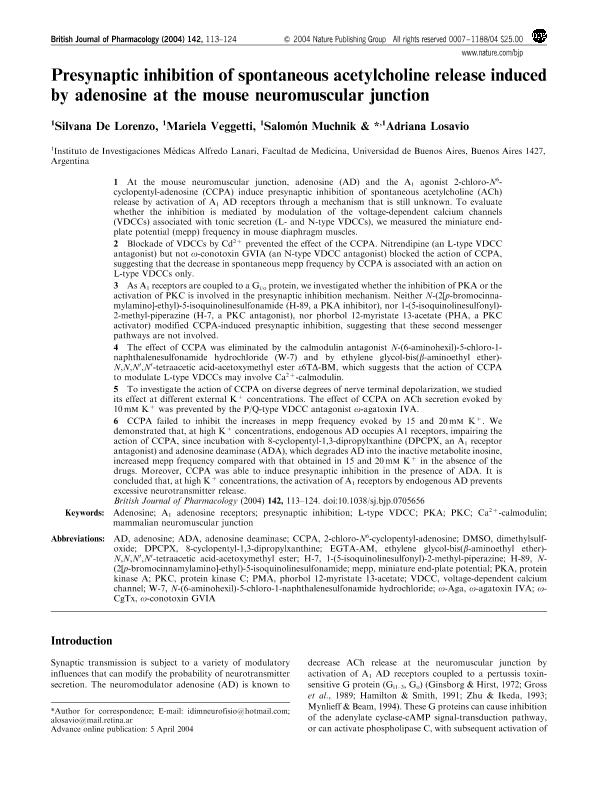Mostrar el registro sencillo del ítem
dc.contributor.author
de Lorenzo, Silvana
dc.contributor.author
Veggetti, Mariela Iris

dc.contributor.author
Muchnik, Salomon

dc.contributor.author
Losavio, Adriana Silvia

dc.date.available
2020-10-27T17:58:32Z
dc.date.issued
2004-05
dc.identifier.citation
de Lorenzo, Silvana; Veggetti, Mariela Iris; Muchnik, Salomon; Losavio, Adriana Silvia; Presynaptic inhibition of spontaneous acetylcholine release induced by adenosine at the mouse neuromuscular junction; Wiley Blackwell Publishing, Inc; British Journal of Pharmacology; 142; 1; 5-2004; 113-124
dc.identifier.issn
0007-1188
dc.identifier.uri
http://hdl.handle.net/11336/116955
dc.description.abstract
1 At the mouse neuromuscular junction, adenosine (AD) and the A1 agonist 2-chloro-N6-cyclopentyl-adenosine (CCPA) induce presynaptic inhibition of spontaneous acetylcholine (ACh)release by activation of A1 AD receptors through a mechanism that is still unknown. To evaluatewhether the inhibition is mediated by modulation of the voltage-dependent calcium channels(VDCCs) associated with tonic secretion (L- and N-type VDCCs), we measured the miniature endplatepotential (mepp) frequency in mouse diaphragm muscles.2 Blockade of VDCCs by Cd2þ prevented the effect of the CCPA. Nitrendipine (an L-type VDCCantagonist) but not o-conotoxin GVIA (an N-type VDCC antagonist) blocked the action of CCPA,suggesting that the decrease in spontaneous mepp frequency by CCPA is associated with an action onL-type VDCCs only.3 As A1 receptors are coupled to a Gi/o protein, we investigated whether the inhibition of PKA or theactivation of PKC is involved in the presynaptic inhibition mechanism. Neither N-(2[p-bromocinnamylamino]-ethyl)-5-isoquinolinesulfonamide (H-89, a PKA inhibitor), nor 1-(5-isoquinolinesulfonyl)-2-methyl-piperazine (H-7, a PKC antagonist), nor phorbol 12-myristate 13-acetate (PHA, a PKCactivator) modified CCPA-induced presynaptic inhibition, suggesting that these second messengerpathways are not involved.4 The effect of CCPA was eliminated by the calmodulin antagonist N-(6-aminohexil)-5-chloro-1-naphthalenesulfonamide hydrochloride (W-7) and by ethylene glycol-bis(b-aminoethyl ether)-N,N,N0,N0-tetraacetic acid-acetoxymethyl ester e6TD-BM, which suggests that the action of CCPAto modulate L-type VDCCs may involve Ca2þ-calmodulin.5 To investigate the action of CCPA on diverse degrees of nerve terminal depolarization, we studiedits effect at different external Kþ concentrations. The effect of CCPA on ACh secretion evoked by10mM Kþ was prevented by the P/Q-type VDCC antagonist o-agatoxin IVA.6 CCPA failed to inhibit the increases in mepp frequency evoked by 15 and 20mM Kþ. Wedemonstrated that, at high Kþ concentrations, endogenous AD occupies A1 receptors, impairing theaction of CCPA, since incubation with 8-cyclopentyl-1,3-dipropylxanthine (DPCPX, an A1 receptorantagonist) and adenosine deaminase (ADA), which degrades AD into the inactive metabolite inosine,increased mepp frequency compared with that obtained in 15 and 20mM Kþ in the absence of thedrugs. Moreover, CCPA was able to induce presynaptic inhibition in the presence of ADA. It isconcluded that, at high Kþ concentrations, the activation of A1 receptors by endogenous AD preventsexcessive neurotransmitter release.
dc.format
application/pdf
dc.language.iso
eng
dc.publisher
Wiley Blackwell Publishing, Inc

dc.rights
info:eu-repo/semantics/openAccess
dc.rights.uri
https://creativecommons.org/licenses/by-nc-sa/2.5/ar/
dc.subject
ADENOSINE
dc.subject
A1 ADENOSINE RECEPTORS
dc.subject
PRESYNAPTIC INHIBITION
dc.subject
MAMMALIAN NEUROMUSCULAR JUNCTION
dc.subject.classification
Neurociencias

dc.subject.classification
Medicina Básica

dc.subject.classification
CIENCIAS MÉDICAS Y DE LA SALUD

dc.title
Presynaptic inhibition of spontaneous acetylcholine release induced by adenosine at the mouse neuromuscular junction
dc.type
info:eu-repo/semantics/article
dc.type
info:ar-repo/semantics/artículo
dc.type
info:eu-repo/semantics/publishedVersion
dc.date.updated
2020-06-23T14:52:20Z
dc.journal.volume
142
dc.journal.number
1
dc.journal.pagination
113-124
dc.journal.pais
Reino Unido

dc.journal.ciudad
Londres
dc.description.fil
Fil: de Lorenzo, Silvana. Universidad de Buenos Aires. Facultad de Medicina. Instituto de Investigaciones Médicas; Argentina
dc.description.fil
Fil: Veggetti, Mariela Iris. Consejo Nacional de Investigaciones Científicas y Técnicas. Oficina de Coordinación Administrativa Houssay. Instituto de Investigaciones Médicas. Universidad de Buenos Aires. Facultad de Medicina. Instituto de Investigaciones Médicas; Argentina
dc.description.fil
Fil: Muchnik, Salomon. Consejo Nacional de Investigaciones Científicas y Técnicas. Oficina de Coordinación Administrativa Houssay. Instituto de Investigaciones Médicas. Universidad de Buenos Aires. Facultad de Medicina. Instituto de Investigaciones Médicas; Argentina
dc.description.fil
Fil: Losavio, Adriana Silvia. Consejo Nacional de Investigaciones Científicas y Técnicas. Oficina de Coordinación Administrativa Houssay. Instituto de Investigaciones Médicas. Universidad de Buenos Aires. Facultad de Medicina. Instituto de Investigaciones Médicas; Argentina
dc.journal.title
British Journal of Pharmacology

dc.relation.alternativeid
info:eu-repo/semantics/altIdentifier/url/https://bpspubs.onlinelibrary.wiley.com/doi/full/10.1038/sj.bjp.0705656
dc.relation.alternativeid
info:eu-repo/semantics/altIdentifier/doi/https://doi.org/10.1038/sj.bjp.0705656
Archivos asociados
